Water bird. Anseriformes (ducks, geese,
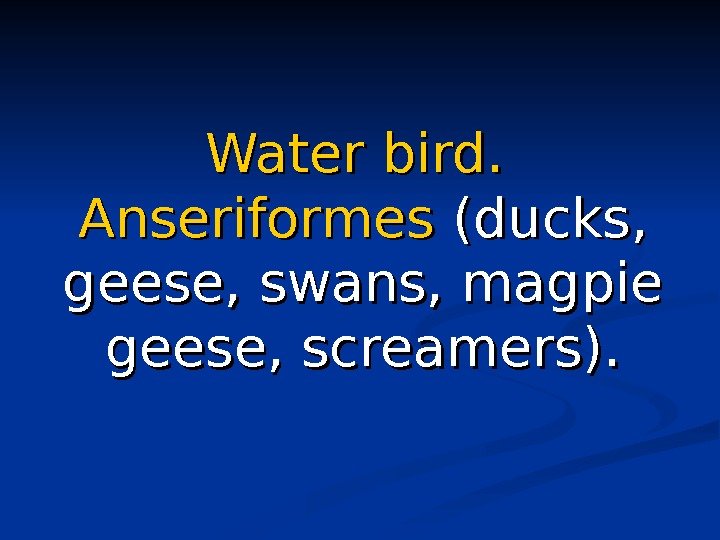
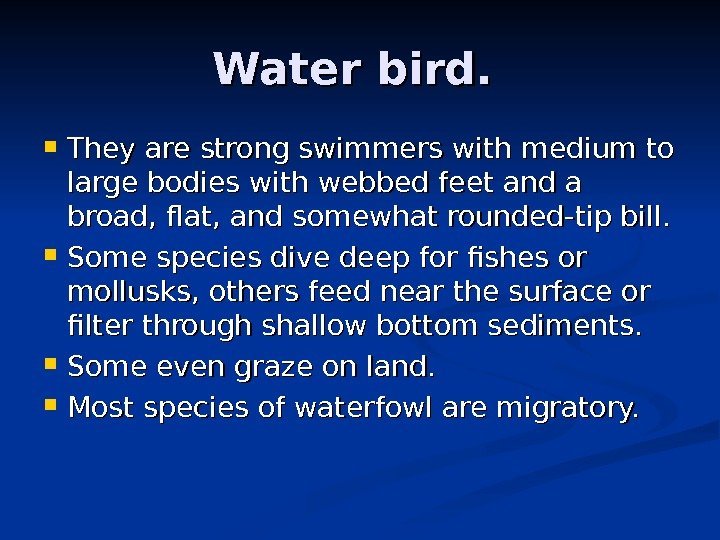
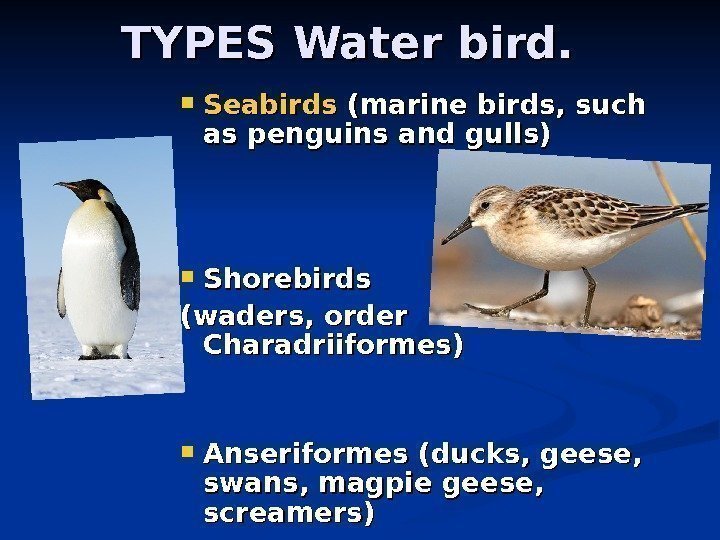
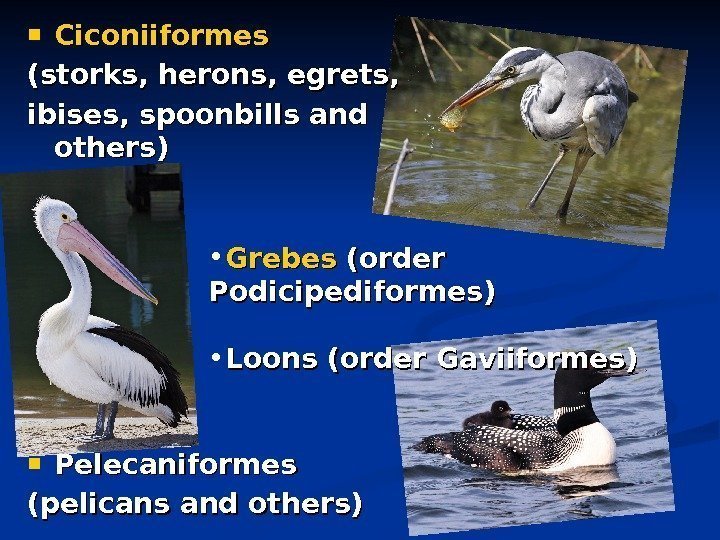
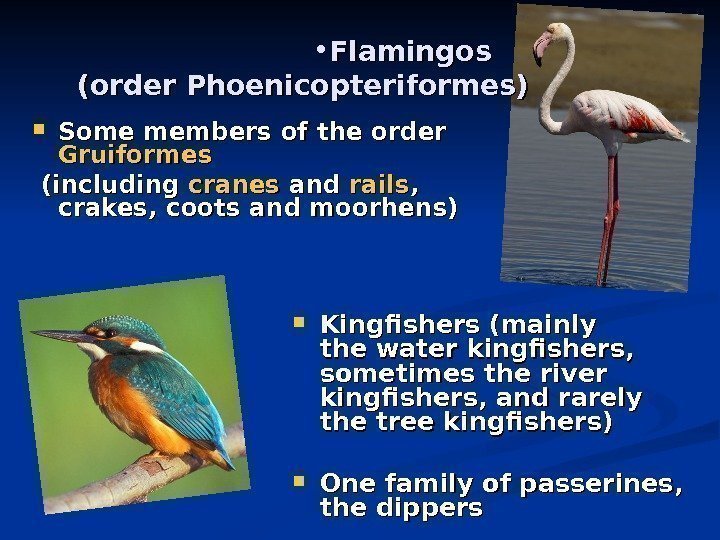
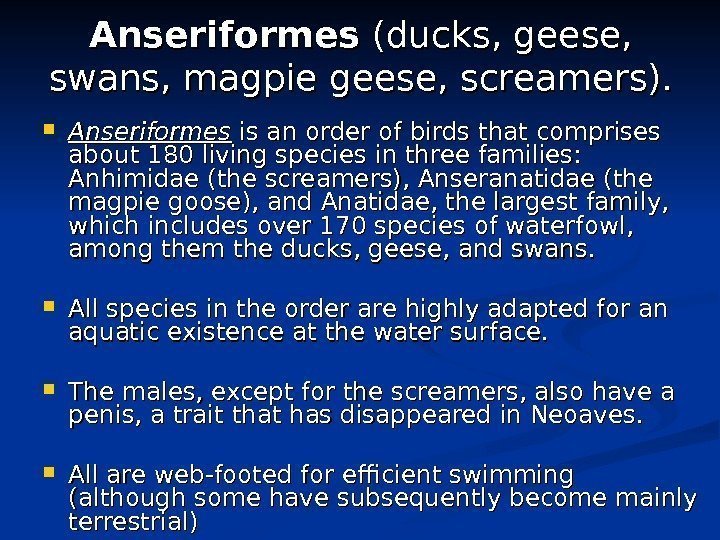
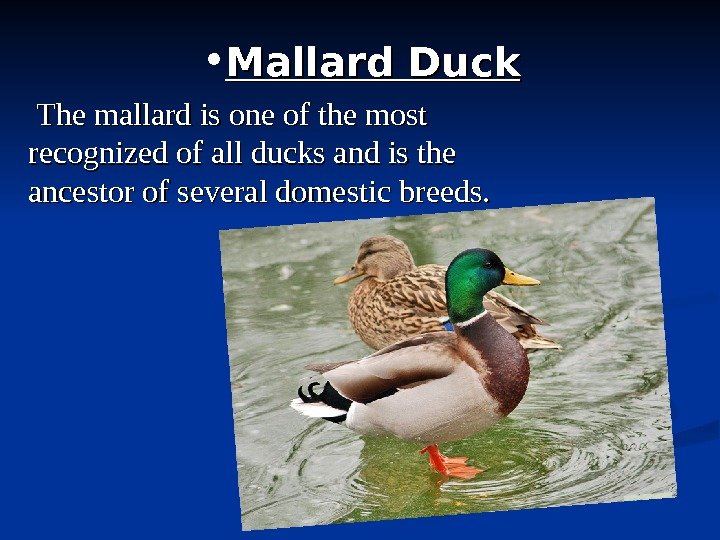
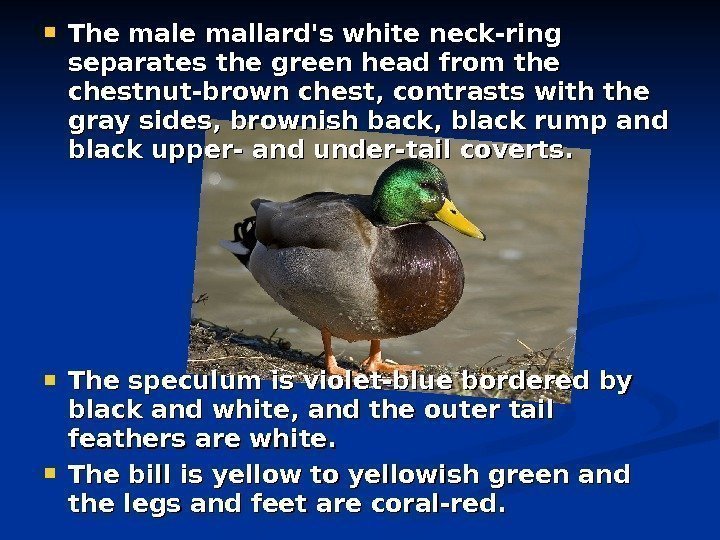
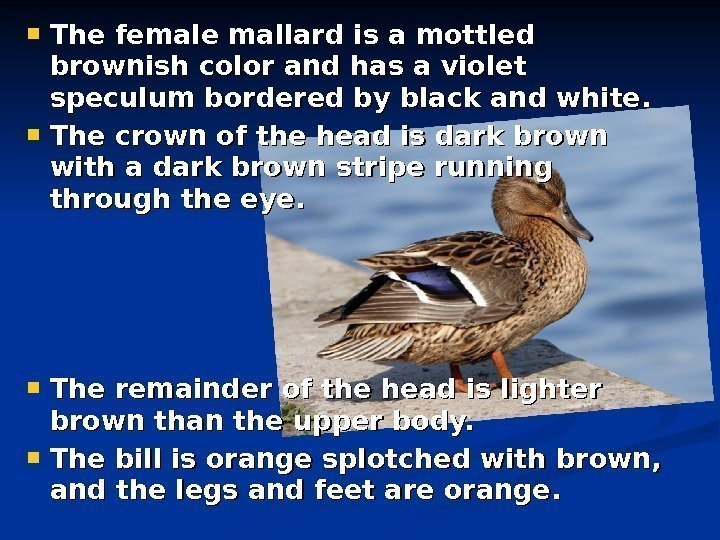
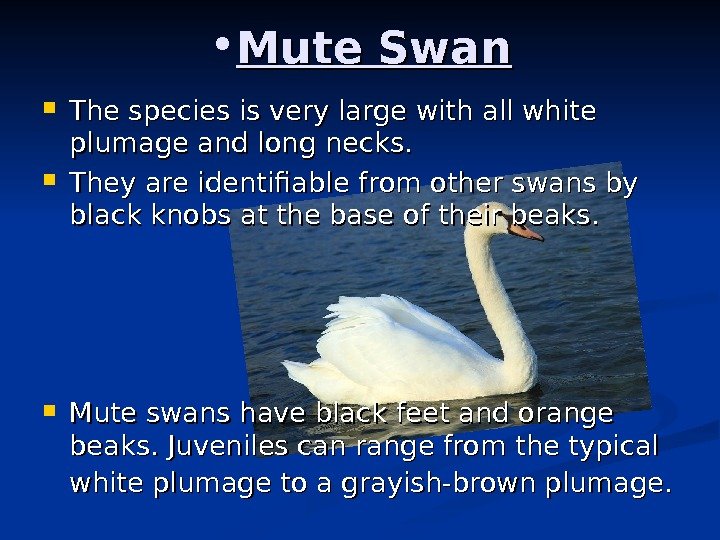
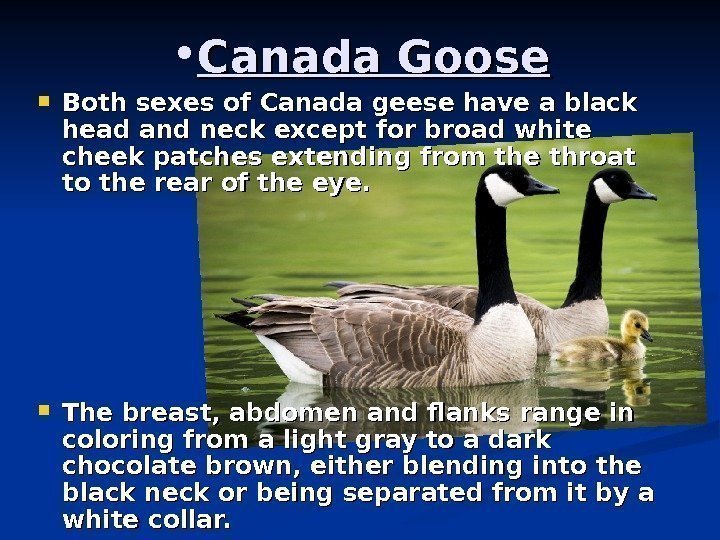
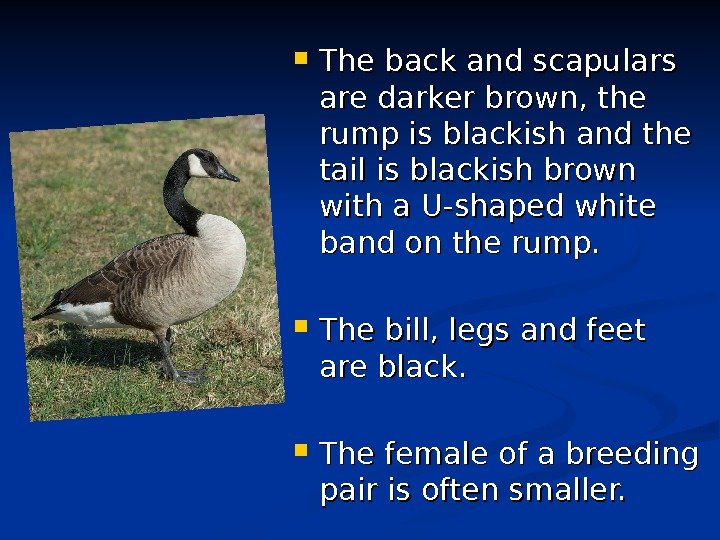


dudinova_721.ppt
- Размер: 2.4 Мб
- Автор:
- Количество слайдов: 14
Описание презентации Water bird. Anseriformes (ducks, geese, по слайдам
 Water bird. Anseriformes (ducks, geese, swans, magpie geese, screamers).
Water bird. Anseriformes (ducks, geese, swans, magpie geese, screamers).
 Water bird. They are strong swimmers with medium to large bodies with webbed feet and a broad, flat, and somewhat rounded-tip bill. Some species dive deep for fishes or mollusks, others feed near the surface or filter through shallow bottom sediments. Some even graze on land. Most species of waterfowl are migratory.
Water bird. They are strong swimmers with medium to large bodies with webbed feet and a broad, flat, and somewhat rounded-tip bill. Some species dive deep for fishes or mollusks, others feed near the surface or filter through shallow bottom sediments. Some even graze on land. Most species of waterfowl are migratory.
 TYPES Water bird. Seabirds (marine birds, such as penguins and gulls) Shorebirds (waders, order Charadriiformes) Anseriformes(ducks, geese, swans, magpie geese, screamers)
TYPES Water bird. Seabirds (marine birds, such as penguins and gulls) Shorebirds (waders, order Charadriiformes) Anseriformes(ducks, geese, swans, magpie geese, screamers)
 Ciconiiformes (storks, herons, egrets, ibises, spoonbills and others) Pelecaniformes (pelicans and others) • Grebes (order Podicipediformes) • Loons(order Gaviiformes)
Ciconiiformes (storks, herons, egrets, ibises, spoonbills and others) Pelecaniformes (pelicans and others) • Grebes (order Podicipediformes) • Loons(order Gaviiformes)
 • Flamingos (order Phoenicopteriformes) Some members of the order Gruiformes (including cranes andand rails , , crakes, coots and moorhens) Kingfishers(mainly thewater kingfishers, sometimes theriver kingfishers, and rarely thetree kingfishers) One family ofpasserines, thedippers
• Flamingos (order Phoenicopteriformes) Some members of the order Gruiformes (including cranes andand rails , , crakes, coots and moorhens) Kingfishers(mainly thewater kingfishers, sometimes theriver kingfishers, and rarely thetree kingfishers) One family ofpasserines, thedippers
 Anseriformes (ducks, geese, swans, magpie geese, screamers). Anseriformes is an order of birds that comprises about 180 living species in three families: Anhimidae (the screamers), Anseranatidae (the magpie goose), and Anatidae, the largest family, which includes over 170 species of waterfowl, among them the ducks, geese, and swans. All species in the order are highly adapted for an aquatic existence at the water surface. The males, except for the screamers, also have a penis, a trait that has disappeared in. Neoaves. All are web-footed for efficient swimming (although some have subsequently become mainly terrestrial)
Anseriformes (ducks, geese, swans, magpie geese, screamers). Anseriformes is an order of birds that comprises about 180 living species in three families: Anhimidae (the screamers), Anseranatidae (the magpie goose), and Anatidae, the largest family, which includes over 170 species of waterfowl, among them the ducks, geese, and swans. All species in the order are highly adapted for an aquatic existence at the water surface. The males, except for the screamers, also have a penis, a trait that has disappeared in. Neoaves. All are web-footed for efficient swimming (although some have subsequently become mainly terrestrial)
 • Mallard Duck The mallard is one of the most recognized of all ducks and is the ancestor of several domestic breeds.
• Mallard Duck The mallard is one of the most recognized of all ducks and is the ancestor of several domestic breeds.
 The male mallard’s white neck-ring separates the green head from the chestnut-brown chest, contrasts with the gray sides, brownish back, black rump and black upper- and under-tail coverts. The speculum is violet-blue bordered by black and white, and the outer tail feathers are white. The bill is yellow to yellowish green and the legs and feet are coral-red.
The male mallard’s white neck-ring separates the green head from the chestnut-brown chest, contrasts with the gray sides, brownish back, black rump and black upper- and under-tail coverts. The speculum is violet-blue bordered by black and white, and the outer tail feathers are white. The bill is yellow to yellowish green and the legs and feet are coral-red.
 The female mallard is a mottled brownish color and has a violet speculum bordered by black and white. The crown of the head is dark brown with a dark brown stripe running through the eye. The remainder of the head is lighter brown than the upper body. The bill is orange splotched with brown, and the legs and feet are orange.
The female mallard is a mottled brownish color and has a violet speculum bordered by black and white. The crown of the head is dark brown with a dark brown stripe running through the eye. The remainder of the head is lighter brown than the upper body. The bill is orange splotched with brown, and the legs and feet are orange.
 • Mute Swan The species is very large with all white plumage and long necks. They are identifiable from other swans by black knobs at the base of their beaks. Mute swans have black feet and orange beaks. Juveniles can range from the typical white plumage to a grayish-brown plumage.
• Mute Swan The species is very large with all white plumage and long necks. They are identifiable from other swans by black knobs at the base of their beaks. Mute swans have black feet and orange beaks. Juveniles can range from the typical white plumage to a grayish-brown plumage.
 • Canada Goose Both sexes of Canada geese have a black head and neck except for broad white cheek patches extending from the throat to the rear of the eye. The breast, abdomen and flanks range in coloring from a light gray to a dark chocolate brown, either blending into the black neck or being separated from it by a white collar.
• Canada Goose Both sexes of Canada geese have a black head and neck except for broad white cheek patches extending from the throat to the rear of the eye. The breast, abdomen and flanks range in coloring from a light gray to a dark chocolate brown, either blending into the black neck or being separated from it by a white collar.
 The back and scapulars are darker brown, the rump is blackish and the tail is blackish brown with a U-shaped white band on the rump. The bill, legs and feet are black. The female of a breeding pair is often smaller.
The back and scapulars are darker brown, the rump is blackish and the tail is blackish brown with a U-shaped white band on the rump. The bill, legs and feet are black. The female of a breeding pair is often smaller.
 Thank you for your attention.
Thank you for your attention.
 DID THE WORK OF DASHA DUDINOVA. GROUP OF 721/
DID THE WORK OF DASHA DUDINOVA. GROUP OF 721/
